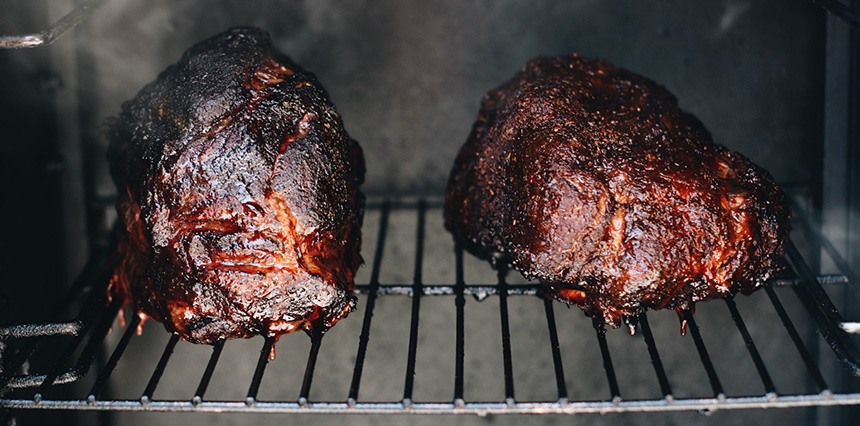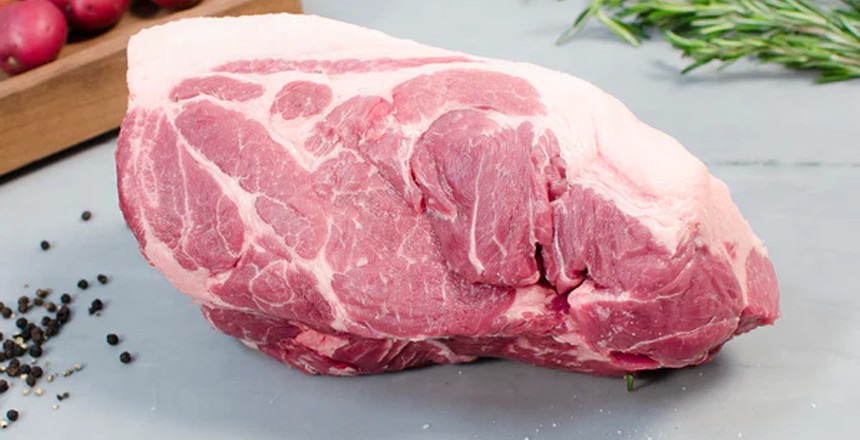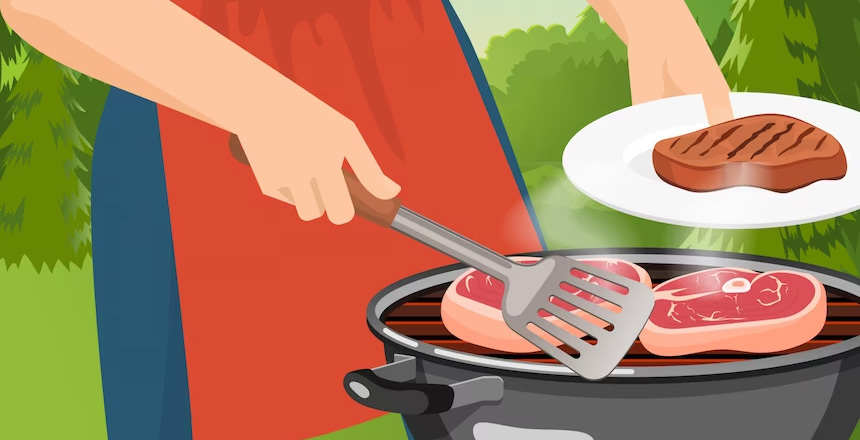Get ready to embark on a flavor-packed journey as we delve into the art of smoking a pork butt for the ultimate pulled pork experience. Smoking a pork butt is not just about cooking—it’s about creating an explosion of taste and tenderness that will leave you craving more. So, how to smoke a pork butt for pulled pork?
Now, we will unravel the secrets to achieving perfectly smoked pulled pork, from selecting the finest cut and infusing it with mouthwatering flavors to mastering the art of low and slow cooking. Whether you’re a seasoned Pitmaster or a curious beginner, these detailed instructions will equip you with the knowledge and techniques to create smokily, melt-in-your-mouth pulled pork that will have your friends and family begging for seconds.
Related:
- How Long to Bake Pork Chops at 350 F
- How Long To Smoke Pork Shoulder At 275
- How Long To Cook Pork Shoulder At 350
- When To Wrap Pork Butt
- How Long To Smoke A Pork Butt At 250
What is Smoked Pulled Pork?

Smoked pulled pork is more than just a dish, it’s an experience that draws people from all walks of life. It is a beloved and mouthwatering dish that showcases the art of slow-cooking a pork shoulder or pork butt over low heat, often in a specialized smoker or barbecue pit.
This cooking method infuses the meat with a delectable, smoky flavor while working its magic to tenderize the tough fibers, resulting in incredibly juicy and flavorful pulled pork.
How To Buy Pork Butt For Pulled Pork?

When it comes to buying pork butt for pulled pork, there are a few things to keep in mind to ensure you get the best cut of meat for your dish.
First, choose pork butt (also known as Boston Butt) over picnic ham, as it is the preferred cut for pulled pork due to its marbling, tenderness, and flavor.
Next, decide whether to purchase bone-in or boneless pork butt. It is generally recommended to opt for bone-in, as the bone adds flavor and helps retain moisture during the cooking process, resulting in a juicier end product.
Consider the weight of the pork butt based on the number of servings you need. Pork butts typically range from 5 to 9 pounds, so choose a size that suits your requirements. For smaller gatherings, a smaller-sized pork butt will suffice, while larger crowds may call for a larger cut.
When examining the pork butt, look for good marbling throughout the meat. Marbling refers to the streaks of fat running through the muscle, and more marbling indicates a more flavorful and tender outcome. Additionally, ensure the pork butt is fresh by checking its color and odor. Look for pinkish-red meat, as any discoloration could be a sign that it is not as fresh. The pork butt should also have a mild, fresh smell.
How Long to Smoke Pork Butt For Pulled Pork?
The smoking time for a pork butt can vary based on factors such as its size, cooking temperature, and smoker consistency. As a general guideline, you can estimate a smoking time of roughly 1.5 to 2 hours per pound of pork butt at a heat range spanning from 225 to 250 degrees Fahrenheit (107 to 121 degrees Celsius).
For instance, a 6-pound pork butt would typically take approximately 9 to 12 hours to smoke until it reaches an internal temperature of 195-205°F (90-96°C). However, it’s important to note that these are estimates, and actual cooking times may differ. To ensure accuracy, utilize an instant-read meat thermometer to track the internal temperature and achieve your preferred level of tenderness while cooking the pork.
Ingredients for Smoked Pork Butt For Pulled Pork
To make smoked pulled pork, you will need:
- Pork butt or pork shoulder (4-6 pounds)
- Dry rub (store-bought or homemade)
- Wood chips or chunks (hickory, apple, mesquite, etc.)
- Barbecue sauce (optional)
- Optional sides (coleslaw, pickles, onions)
- Spritzing liquid (optional, such as apple juice or apple cider vinegar)
How to Smoke a Pork Butt for Pulled Pork?
Prepare the Pork Butt
Remove the pork butt from its packaging and trim off any excess fat if desired. Leaving a thin layer of fat can help keep the meat moist during smoking. Apply a generous amount of dry rub to all sides of the pork butt, ensuring it is evenly coated. Allow the pork butt to sit at room temperature for about 30 minutes to allow the flavors to penetrate the meat.
Preheat the Smoker
Heat up your smoker to the desired temperature of around 225-250°F (107-121°C). Use a combination of charcoal and wood chunks or chips to generate smoke. Popular wood choices for smoking pork include hickory, apple, or cherry.
Position The Pork Butt Inside The Smoker
Once the smoker is preheated and producing smoke, place the seasoned pork butt directly on the cooking grate, fat side up. Close the lid of the smoker.
Maintain the Smoking Temperature
Throughout the smoking process, it’s important to maintain a consistent temperature. Monitor the smoker’s temperature using a thermometer and adjust the airflow and fuel as needed to keep the heat steady.
Smoke the Pork Butt
Let the pork butt smoke at a gradual pace for a few hours until it reaches an internal temperature of approximately 195-205°F (90-96°C). This slow and gentle cooking method will effectively tenderize the meat by breaking down the connective tissues, yielding irresistibly tender pulled pork. It typically takes 1.5 to 2 hours per pound of pork butt, but cooking times can vary.
Rest and Shred
After the pork butt reaches the desired internal temperature, delicately take it out of the smoker and wrap it tightly in aluminum foil. Give the meat a minimum of 30 minutes to rest, allowing the juices to evenly distribute throughout. After resting, use two forks or meat claws to shred the pork, discarding any excess fat or bone.
Serve and Enjoy
Serve the smoked pulled pork on buns or rolls, drizzled with your favorite barbecue sauce. Consider adding sides like coleslaw, pickles, or onions to complete the meal.
Tips For Smoking Pork Butt For Pulled Pork
Here are some tips for smoking pork to help you achieve delicious results:
- Keep It Simple: Focus on enhancing the natural flavors of the pork rather than overpowering it with too many seasonings or sauces.
- Trim the Fat: While some fat is desirable for flavor and moisture, excessive fat can prevent the smoke and seasonings from penetrating the meat. Trim any thick or uneven fat layers before smoking.
- Take the Time to Season Right: Apply a generous amount of dry rub to all sides of the pork, ensuring it is evenly coated. Allow the seasoned pork to sit for a while to let the flavors penetrate the meat before smoking.
- Enhance Flavor with Wood Pellets: Choose high-quality wood pellets that complement the flavor of pork, such as hickory, apple, cherry, or pecan. Experiment with different wood combinations to find your favorite flavor profile.
- Use a Meat Thermometer: Invest in a reliable meat thermometer to monitor the temperature inside the pork. This ensures it reaches the desired level of doneness and prevents overcooking or undercooking.
- Keep It Low and Slow: Maintain a consistently low temperature, usually around 225-250°F (107-121°C), for a prolonged period. This slow-cooking method allows the pork to become tender, juicy, and infused with smoky flavors.
- Plan for the Stall: The internal temperature of the pork may plateau during cooking, known as the “stall.” This is normal and can last for several hours. Be patient and maintain the temperature until the pork starts to rise again.
- Let It Rest (This Is Key): After removing the pork from the smoker, let it rest for at least 30 minutes. This allows the juices to redistribute, resulting in a more flavorful and moist end result.
How to Store Smoked Pulled Pork?
To store smoked pulled pork, allow it to cool at room temperature before packaging it in airtight containers or heavy-duty freezer bags.
If you plan to consume it within a few days, store it in the refrigerator. For longer storage, freeze the pulled pork in freezer-safe containers or bags, ensuring to remove excess air to prevent freezer burn. In the refrigerator, consume the pulled pork within 3-4 days, while in the freezer, it can be stored for 2-3 months without significant loss in quality.
When ready to use, thaw it in the refrigerator overnight or use the defrost setting on the microwave. To reheat, gently warm it in a skillet, bake it covered in the oven, or use a low-power setting in the microwave. Always follow food safety guidelines and discard any spoiled or improperly stored pulled pork.
FAQs
How Do You Keep Pulled Pork Juicy in a Smoker?
To keep pulled pork juicy in a smoker: Choose a well-marbled cut like pork butt, brine or marinate the meat beforehand, and leave a thin layer of fat on the pork butt.
How Long Does It Take to Smoke 8 lb Pork Butt?
When smoking an 8-pound pork butt, you can estimate a smoking time of approximately 12 to 16 hours.
What is The Best Temp For Fall Apart Pulled Pork?
An internal temperature of 205°F (96°C) is considered the ideal temperature for fall-apart, tender pulled pork.
What Liquid Keeps Pulled Pork Moist?
There are several liquids that can help keep pulled pork moist: BBQ Sauce, Apple Cider Vinegar, Fruit Juices..
Do You Flip a Pulled Pork While Smoking?
No, it is generally not necessary to flip pulled pork while smoking. The process of smoking is a slow and indirect cooking method that allows the heat and smoke to circulate evenly around the meat.
Conclusion
You have now mastered the art of smoking a pork butt for incredible pulled pork. By following the steps and tips outlined in this guide, you have unlocked the secrets to achieving tender, juicy, and flavor-packed results that will leave everyone craving more.
Remember, patience and attention to detail are the keys to success. From selecting the right cut and seasonings to maintaining the ideal temperature and monitoring cooking times, each step contributes to the final masterpiece. The smoky aroma, the succulent texture, and the harmonious blend of flavors will be a testament to your skills as a pitmaster.
Now it’s time to share your mouth-watering creation with friends and loved ones.


